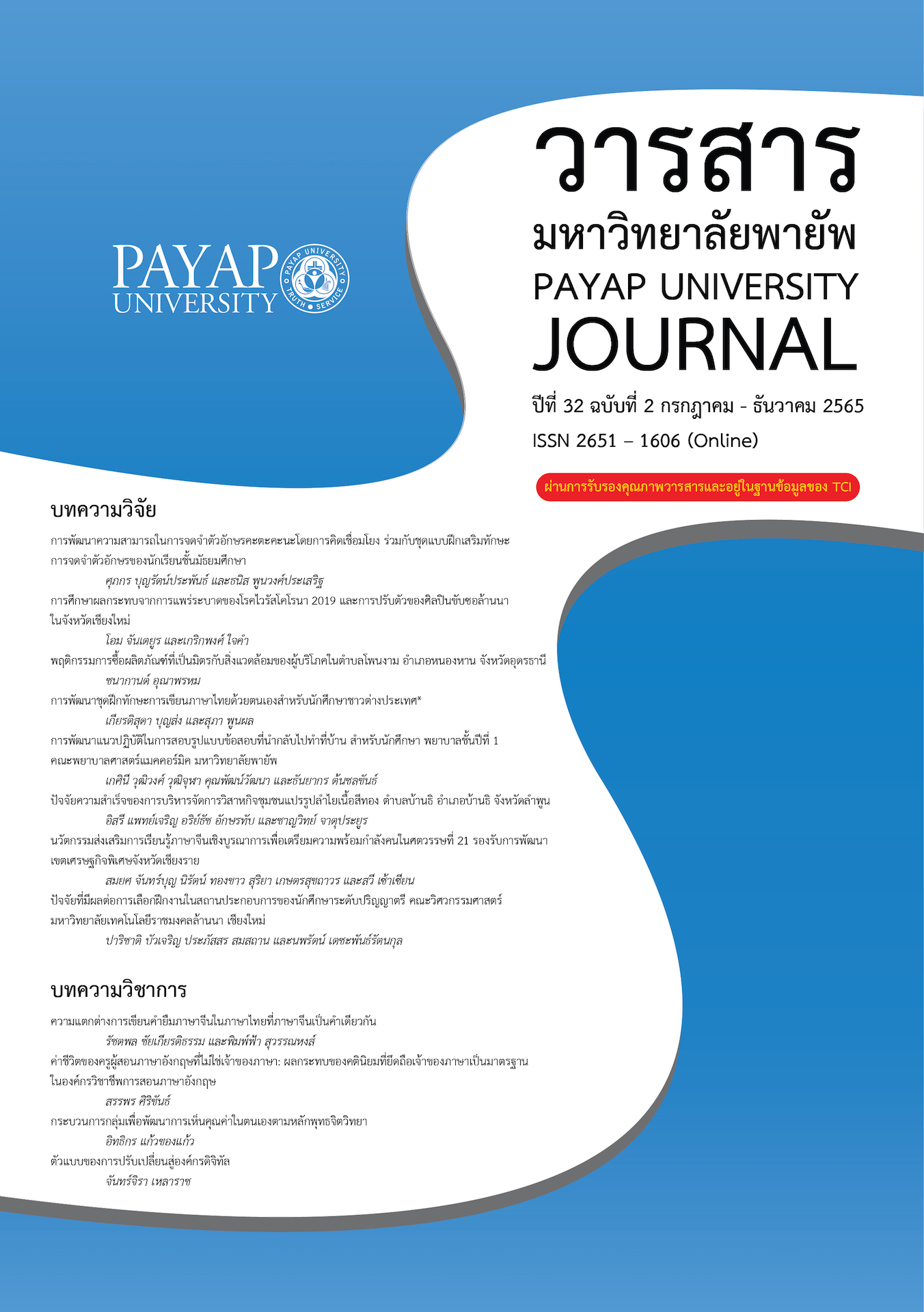The Differences of Single-Character Chinese Loanwords in Thai Writing
Main Article Content
Abstract
This article aimed to explain the differences of single-character Chinese loanwords in Thai writing in 2 volumes of the Royal Institute Dictionary: the 2011 Royal Institute Dictionary (2013) and Dictionary of New words Vol.1 & 2 (2014). According to the results, the total of differences of single-character Chinese loanwords in Thai writing is 17 categories. The 菜 (cài) is the most used category with 11 different words, accounting for 17.18 percent of 64 words. This category also shows the most four types of including the syllable of “ฉ่าย” (cà:i) “ช่าย” (câ:i) “ไช” (cai) and “ไช้” (cái). Especially, the syllable of “ฉ่าย” (cà:i) and “เต้า” (dâo) are the most found in 6 different words of their use. The differences of single-character Chinese loanwords in Thai writing are identified by three orthography factors: 1) accent of Chinese dialects, 2) semantics, and 3) unsystematic written pattern. Thai language users should learn and memorize the differences of single-character Chinese loanwords in Thai writing aiming to achieve accuracy and efficiency in communication.
Article Details
References
ชลธิชา บำรุงรักษ์. (2555). เอกสารประกอบการสอนรายวิชา “หัวข้อศึกษาเฉพาะด้านระบบคำและประโยค ภ. 802”. มหาวิทยาลัยธรรมศาสตร์.
ชัยวัฒน์ มีสัณฐาน. (2555). ชาวมลายูบางกอก: ภาษาและเรื่องเล่า. วารสารภาษาและภาษาศาสตร์, 30(2), 24-42.
เธียรชัย เอี่ยมวรเมธ. (2560). พจนานุกรมจีน-ไทย ฉบับใหม่ (พิมพ์ครั้งที่ 34). อมรการพิมพ์.
นวรัตน์ ภักดีคำ. (2553). จีนใช้ไทยยืม. อมรินทร์.
นววรรณ พันธุเมธา. (2559). คลังคำ (พิมพ์ครั้งที่ 7). อมรินทร์.
พิชณี โสตถิโยธิน. (2555). คำยืมภาษาจีนแต้จิ๋วในภาษาไทย: ปรากฏการณ์ที่วงศัพท์อันเนื่องมาจากการเปลี่ยนแปลงความหมาย. วารสารจีนศึกษา, 5(5), 129-162.
พจนานุกรมฉบับมติชน = Matichon dictionary of the Thai language. (2547). มติชน.
ราชบัณฑิตยสถาน. (2546). พจนานุกรมฉบับราชบัณฑิตยสถาน พ.ศ. 2542. นานมีบุ๊คส์.
ราชบัณฑิตยสถาน. (2550). หลักเกณฑ์การทับศัพท์ภาษาจีนและภาษาฮินดี. อมรินทร์.
ราชบัณฑิตยสถาน. (2556). พจนานุกรมฉบับราชบัณฑิตยสถาน พ.ศ. 2554. ศิริวัฒนาอินเตอร์พริ้นท์.
ราชบัณฑิตยสถาน. (2557). พจนานุกรมคำใหม่ฉบับราชบัณฑิตยสถาน เล่ม 1-2. นานมีบุ๊คส์.
ราชบัณฑิตยสภา. (2561). อ่านอย่างไรและเขียนอย่างไร ฉบับราชบัณฑิตยสภา (พิมพ์ครั้งที่ 23 (แก้ไขเพิ่มเติม)). ราชบัณฑิตยสถาน.
ราชบัณฑิตยสภา. (2564, 29 มิถุนายน). ประกาศสำนักงานราชบัณฑิตยสภา เรื่อง กำหนดชื่อประเทศดินแดน เขตการปกครอง และเมืองหลวง. สำนักงานราชราชบัณฑิตยสภา. https://www.orst.go.th/iwfm_list.asp?n=g&i=0020000402001002%2F65GLN5247041
ลัดดา วรลัคนากุล. (ม.ป.ป). คำภาษาจีนในภาษาไทย (๑). สำนักงานราชราชบัณฑิตยสภา. http://legacy.orst.go.th/?knowledges=คำภาษาจีนในภาษาไทย-๑
วรศักดิ์ มหัทธโนบล. (2555). คำจีนสยาม ภาพสะท้อนปฏิสัมพันธ์ไทย–จีน. อมรินทร์.
บักกุดเต๋. (2565, 6 กุมภาพันธ์). วิกิพีเดีย. https://th.wikipedia.org/wiki/บักกุดเต๋
สุธิวงศ์ พงศ์ไพบูลย์. (2544). หลักภาษาไทย. ไทยวัฒนาพานิช.
อนุมานราชธน, พระยา, (2499). นิรุกติศาสตร์. รุ่งเรืองธรรม.


